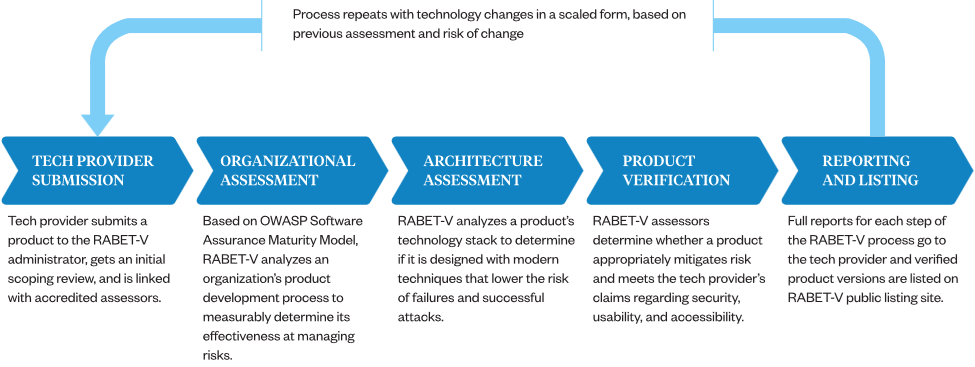RABET-V
The RABET-VTM program uses industry-approved testing standards to help technology providers understand the security, reliability, accessibility, and risks associated with their products.
A verification program is a comprehensive third-party review, analysis, and testing of technology to confirm that a system correctly implements the required functionality and security requirements.
What began as a solution to verifying non-voting election technology, including electronic pollbooks, electronic ballot transmission solutions, election night reporting systems, and voter registration systems, is now capable of handling any technology product.
RABET-V introduces testing standards to better understand the security, reliability, and risks associated with a technology product.
Offering a Trusted Solution
Testing technology for security, accessibility, and usability is challenging. The standards to which technology must be verified are often ambiguous or incomplete. The RABET-V program is a rapid, reliable, cost-effective approach to verifying enterprise technologies with standards updated based on industry best practices.
RABET-V works with any software-based technology. Through a mix of manual and automated reviews, RABET-V provides iterative, flexible verification for all technology products. Thoroughly vetted, third-party assessors play a vital role in RABET-V. Assessors are accredited business entities performing organizational, architecture, and product verification assessments for the RABET-V program.
For more details, please see our technical documentation.
- Comprehensive view: Conducts a holistic assessment of the technology producer’s development processes, the product’s architectures, and the product's performance.
- Actionable results: Provides reports on the assessments that support continual improvement and more clarity in procurements.
- Scalability potential: Uses the results from previous assessments and information about product changes to scale the level of testing for future versions.
The Value of RABET-V
- Speed: RABET-V is fast. RABET-V uses industry-leading tools to assess products without seeing a line of source code. RABET-V scopes retesting to only the affected parts of the system, rewarding good architectural and organizational maturity. With seven registered assessors, RABET-V can simultaneously and expediently evaluate multiple products.
- Breadth: Organizations and their solutions are evaluated to ensure they meet maturity benchmarks in three major areas—organizational, architecture, and product implementation—providing a holistic view of the solution.
- Depth: Solutions are tested against 153 security requirements updated regularly and drawn from industry-recognized standards. This creates the most robust testing program for enterprise technology, ensuring the highest confidence that the verified solutions will function as intended.
- Flexibility: While initially developed to focus on the security of non-voting systems, RABET-V expanded to include accessibility and functional testing. RABET-V partners with accredited assessors including Voting System Test Labs (VSTLs) to ensure RABET-V can meet required testing needs.
